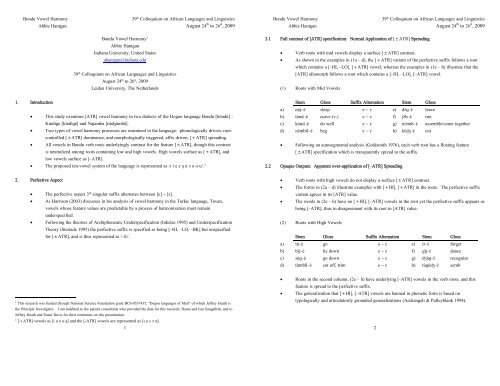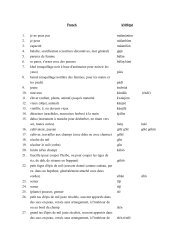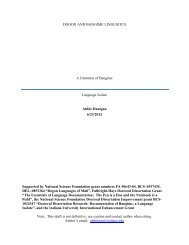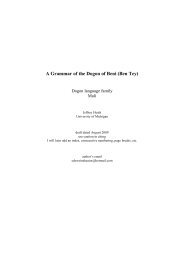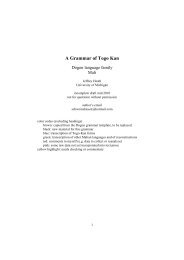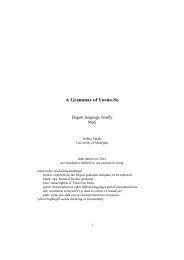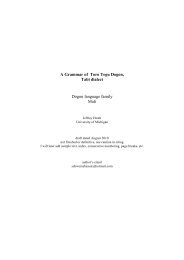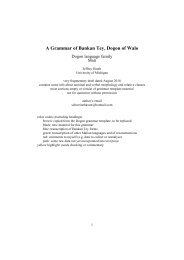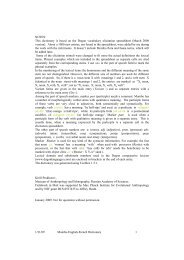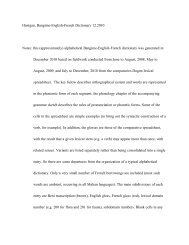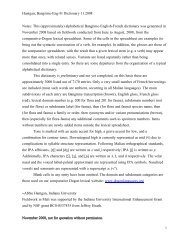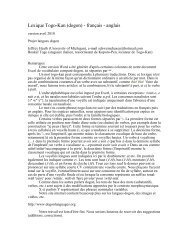Bondu Vowel Harmony - Dogon and Bangime Linguistics
Bondu Vowel Harmony - Dogon and Bangime Linguistics
Bondu Vowel Harmony - Dogon and Bangime Linguistics
- No tags were found...
Create successful ePaper yourself
Turn your PDF publications into a flip-book with our unique Google optimized e-Paper software.
<strong>Bondu</strong> <strong>Vowel</strong> <strong>Harmony</strong> 39 th Colloquium on African Languages <strong>and</strong> <strong>Linguistics</strong>Abbie Hantgan August 24 th to 26 st , 2009<strong>Bondu</strong> <strong>Vowel</strong> <strong>Harmony</strong>F1Abbie HantganIndiana University, United Statesahantgan@indiana.edu39 th Colloquium on African Languages <strong>and</strong> <strong>Linguistics</strong>August 24 th to 26 st , 2009Leiden University, The Netherl<strong>and</strong>s<strong>Bondu</strong> <strong>Vowel</strong> <strong>Harmony</strong> 39 th Colloquium on African Languages <strong>and</strong> <strong>Linguistics</strong>Abbie Hantgan August 24 th to 26 st , 20092.1 Full contrast of [ATR] specification: Normal Application of [±ATR] Spreading• Verb roots with mid vowels display a surface [±ATR] contrast.• As shown in the examples in (1a – d), the [+ATR] variant of the perfective suffix follows a rootwhich contains a [–HI, –LO], [+ATR] vowel, whereas the examples in (1e – h) illustrate that the[ATR] allomorph follows a root which contains a [–HI, –LO], [–ATR] vowel.(1) Roots with Mid <strong>Vowel</strong>s1. Introduction• This study examines [ATR] vowel harmony in two dialects of the <strong>Dogon</strong> language <strong>Bondu</strong> [bòndú] :Kindige [kìndìɡé] <strong>and</strong> Najamba [nàdʒàmbá].• Two types of vowel harmony processes are examined in the language: phonologically driven, rootcontrolled[±ATR] dominance, <strong>and</strong> morphologically triggered, affix driven, [+ATR] spreading.• All vowels in <strong>Bondu</strong> verb roots underlyingly contrast for the feature [±ATR], though this contrastis neutralized among roots containing low <strong>and</strong> high vowels. High vowels surface as [+ATR], <strong>and</strong>low vowels surface as [–ATR].• The proposed ten-vowel system of the language is represented as /ɪ i e ɛ a̘ a ɔ o ʊ u/. F2Stem Gloss Suffix Alternation Stem Glossa) nòj–è sleep e ~ ɛ e) dɔ̀ɡ–ɛ̀ leaveb) tònd–è curve (v.) e ~ ɛ f) jɔ̀b–ɛ̀ runc) kònd–è do well e ~ ɛ g) mɔ̀mb–ɛ̀ assemble/come togetherd) nèmbìl–è beg e ~ ɛ h) kɛ̀dʒ–ɛ̀ cut• Following an autosegmental analysis (Goldsmith 1976), each verb root has a floating feature[±ATR] specification which is transparently spread to the suffix.2.2 Opaque Outputs: Apparent over-application of [–ATR] Spreading2. Perfective Aspect• The perfective aspect 3 rd singular suffix alternates between [e] ~ [ɛ].• As Harrison (2003) discusses in his analysis of vowel harmony in the Turkic language, Tuvan,vowels whose feature values are predictable by a process of harmonization must remainunderspecified.• Following the theories of Archiphonemic Underspecification (Inkelas 1995) <strong>and</strong> UnderspecificationTheory (Steriade 1995) the perfective suffix is specified as being [–HI, –LO, –BK] but unspecifiedfor [±ATR], <strong>and</strong> is thus represented as /–E/.• Verb roots with high vowels do not display a surface [±ATR] contrast.• The forms in (2a – d) illustrate examples with [+HI], [+ATR] in the roots. The perfective suffixvariant agrees in its [ATR] value.• The words in (2e – h) have no [+HI], [–ATR] vowels in the root yet the perfective suffix appears asbeing [–ATR], thus in disagreement with its root in [ATR] value.(2) Roots with High <strong>Vowel</strong>sStem Gloss Suffix Alternation Stem Glossa) ìn–è go e ~ ɛ e) ìr–ɛ̀ forgetb) bìj–è lie down e ~ ɛ f) ɡìj–ɛ̀ dancec) sùɡ–è go down e ~ ɛ g) dʒùɡ–ɛ̀ recognized) tùmbìl–è cut off, trim e ~ ɛ h) tùɡùdʒ–ɛ̀ scrub1This research was funded through National Science Foundation grant BCS-0537435, "<strong>Dogon</strong> languages of Mali” of which Jeffrey Heath is• Roots in the second column, (2e – h) have underlying [–ATR] vowels in the verb roots, <strong>and</strong> thisfeature is spread to the perfective suffix.• The generalization that [+HI], [–ATR] vowels are banned in phonetic form is based ontypologically <strong>and</strong> articulatorily grounded generalizations (Archangeli & Pulleyblank 1994).the Principle Investigator. I am indebted to the patient consultants who provided the data for this research, Hama <strong>and</strong> Issa Sangalbah, <strong>and</strong> toJeffrey Heath <strong>and</strong> Stuart Davis for their comments on this presentation.2 [+ATR] vowels as [i u e o a̘] <strong>and</strong> the [-ATR] vowels are represented as [ɪ ʊ ɛ ɔ a].12
<strong>Bondu</strong> <strong>Vowel</strong> <strong>Harmony</strong> 39 th Colloquium on African Languages <strong>and</strong> <strong>Linguistics</strong>Abbie Hantgan August 24 th to 26 st , 2009(6) Roots with low vowels 3<strong>Bondu</strong> <strong>Vowel</strong> <strong>Harmony</strong> 39 th Colloquium on African Languages <strong>and</strong> <strong>Linguistics</strong>Abbie Hantgan August 24 th to 26 st , 2009Selected ReferencesStem Gloss Suffix Alternation Stem Glossa) ba̘ŕ–á̘ help ––––– e) ba̘á̘ŕ–á̘ instructb) da̘ḿ–á̘ speak ––––– f) dá̘ɡ–á̘ allowc) ɡíná̘ɡ–á̘ break ––––– g) pá̘ɡ–á̘ tied) da̘ḿá̘ɡ–á̘ denigrate ––––– h) wá̘ɲ–á̘ hate• The process of apparent [ATR] harmony found among verbs in the imperative is in fact a process ofraising or parasitic harmony (Cole & Trigo 1988), whereas a root with [–LO] vowels spreads itsheight feature to the imperative suffix.4.3 Summary of Imperative Suffix• The imperative suffix is underspecified for the feature [±ATR] but is specified as being [+LO].• A root spreads its height feature to the imperative suffix:Roots with [+ATR]/[ –HI] vowels cause the suffix to be raised to [o].Roots with [–ATR]/[ –LO] vowels do not raise the suffix.• A floating feature suffix [+ATR] causes imperative stem vowels to become [+ATR].Archangeli, D., & Pulleyblank, D. (1994). Grounded phonology. Cambridge, MA: MIT Press.Bakovic, E. (2000). <strong>Harmony</strong>, dominance <strong>and</strong> control. Rutgers University.Casali, R. (2008). ATR <strong>Harmony</strong> in African Languages. Language <strong>and</strong> <strong>Linguistics</strong> Compass, 2(3), 496-549.Cole, Jennifer, & Loren Trigo (1988). Parasitic <strong>Harmony</strong>. In Smith & Hulst (Eds.), Features, Segmental Structure<strong>and</strong> <strong>Harmony</strong> Processes (Part II) (pp. 19- 38): Published by Walter de Gruyter.Goldsmith, J. Autosegmental Phonology (1976) Bloomington, IN: Indiana University <strong>Linguistics</strong> Club.Heath, J. (2009). Najamba Grammar Draft. from http://dogonlanguages.org/Inkelas, S. (1995). The Consequences of Optimization for Underspecification. In E. Buckley & S. Iatridou (Eds.),Proceedings of the Twenty-Fifth Northeastern Linguistic Society. Amherst: GLSA.Ito, J., Mester, A., & Padgett, J. (1995). Licensing <strong>and</strong> Redundancy: Underspecification in Optimality Theory.Linguistic Inquiry, 26, 571-614.McCarthy, J. (2007). Hidden generalizations : phonological opacity in optimality theory. Oakville, CT: Equinox.5. Conclusions• The opacity found among verb stems in the <strong>Dogon</strong> language of <strong>Bondu</strong> presents problems forcurrently phonological theoretical models such as OT (1993/2004), or more recent attempts toh<strong>and</strong>le this issue (McCarthy 2007).• It can be proposed that <strong>Bondu</strong> historically displayed a full contrast between [±ATR] vowels at thesurface level.• A floating feature suffix [+ATR] causes imperative stem vowels to become [+ATR].• For further research: What is the correct representation of the root in <strong>Bondu</strong>? (hint – ask me aboutabout monosyllabic roots!)Plungian, V. (2007). <strong>Dogon</strong>. München, Newcastle: Lincom Europa.Prince, A., & Smolensky, P. (1993/2004). Optimality Theory: Constraint Interaction in GenerativeGrammar. Malden MA, & Oxford: Blackwell.Steriade, D. (1995). Underspecification <strong>and</strong> Markedness. In J. Goldsmith (Ed.), The H<strong>and</strong>book of PhonologicalTheory. Cambridge, MA: Blackwell.3The surface [ATR] representations of the low vowels in (6) are yet to be decisively determined as preliminary measurements of F1 <strong>and</strong> F2values for the imperative suffix show that roots with underlyingly [–ATR] values take a variant of [a] which is slightly lower than those with[+ATR] vowels in the roots, suggesting there may be two surface variants of the perfective suffix.56
<strong>Bondu</strong> <strong>Vowel</strong> <strong>Harmony</strong> 39 th Colloquium on African Languages <strong>and</strong> <strong>Linguistics</strong>Abbie Hantgan August 24 th to 26 st , 2009AppendixPerfective Stem Imperative Stem Root [+ATR] Gloss[ìnè] [ínó] /in/ go[ìbè] [íbó] /ib/ catch[kìlè] [kíló] /kil/ fence[bìjè] [bíjó] /bij/ lie down[sùɡè] [súɡó] /suɡ/ go down[tùmbìlè] [túmbíló] /tumbil/ cut off, trim[nèmbìlè] [némbíló] /nembil/ beg[nòjè] [nójó] /noj/ sleep[tòndè] [tóndó] /tond/ curve[kòndè] [kóndó] /kond/ do well[ìrɛ̀] [írá] /ɪr/ forget[ɡìjɛ̀] [ɡíjá] /ɡɪj/ dance[dʒùɡɛ̀] [dʒúɡá] /dʒʊɡ/ recognize[kùnɛ̀] [kúná] /kʊn/ fatten[tùɡùdʒɛ̀] [túɡúdʒá] /tʊɡʊdʒ/ scrub[bɛ̀lɛ̀] [bélá] /bɛl/ pick fruit[sɛ̀mɛ̀] [sémá] /sɛm/ slaughter[tɛ̀ɡɛ̀] [téɡá] /tɛɡ/ fall (rain)[kɛ̀dʒɛ̀] [kédʒá] /kɛdʒ/ cut[dɔ̀ɡɛ̀] [dóɡá] /dɔɡ/ leave[jɔ̀bɛ̀] [jóbá] /jɔb/ run[mɔ̀mbɛ̀] [mómbá] /mɔmb/ assemble/come together[dàɡɛ̀] [dáɡá] /da̜ɡ/ allow, licit[pàɡɛ̀] [páɡá] /pa̙ɡ/ tie[wàɲɛ̀] [wáɲá] /wa̜ɲ/ hate (v.)[bààrɛ̀] [báárá] /ba̜a̜r/ instruct[ɡìnàɡè] [ɡínáɡá] /ɡinaɡ/ break[bàrè] [bárá] /bar/ help[dàmè] [dámá] /dam/ speak[kànè] [káná] /kan/ do[wàdʒè] [wádʒá] /wadʒ/ remain[dàmàɡè] [dámáɡá] /damaɡ/ denigrate7


